|
|
|
Sort Order |
|
|
|
Items / Page
|
|
|
|
|
|
|
| Srl | Item |
| 1 |
ID:
173832
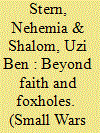

|
|
|
|
|
| Summary/Abstract |
This paper explores the vernacular roles that religious practices and experiences play within contemporary combat units of the Israel Defense Forces (IDF). We argue for an anthropological perspective that highlights the modes through which rituals serve efficacious – as opposed to semiotic – ends. In this way, we seek to push back against what we term the ‘faith in a foxhole’ paradigm, where religion is primarily seen as a meaning-making system whose nearly sole function is to aid soldiers in coping with the chaos and uncertainty of combat. We demonstrate how amidst the low-level and long-term style of contemporary asymmetrical warfare, ritual practices can often function less as the matrix for broader meaning making systems but are rather mobilized in ways that are meant to support certain practical and pragmatic goals. The article concludes that while scholars have mostly focused attention on the institutional forces and political consequences of ‘religionization’ within Israeli society, they have missed the many vernacular ways in which Israelis mobilize and instrumentalize their use of ritual and religious practices in both military and civilian contexts.
|
|
|
|
|
|
|
|
|
|
|
|
|
|
|
|
| 2 |
ID:
183454
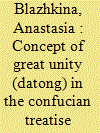

|
|
|
|
|
| Summary/Abstract |
This article analyzes the concept of Great Unity (datong), textually enshrined in the Liyun section of the treatise Kongzi Jiayu. Confucian thinkers consider the concept of Great Unity to be the ideal state in which the Celestial Empire existed in the period of golden antiquity. This concept is of direct relevance to contemporary Chinese political culture. It was embodied in the idea of the "Community of Common Destiny for Mankind" (renlei mingyun gongtongti), proposed by Xi Jinping, General Secretary of the CPC Central Committee, in November 2012, at the 18th CPC Congress. This article reveals the main ideological content of the Liyun section of Kongzi Jiayu and makes a preliminary comparison with the chapter of the same name from the famous written artifact Liji.
|
|
|
|
|
|
|
|
|
|
|
|
|
|
|
|
| 3 |
ID:
151474


|
|
|
|
|
| Summary/Abstract |
In Laos, cultural festivals and other forms of ethnic display communicate locality and ethnicity to external agencies, in particular the nation state. This article documents strategies of identity-making in a small festival that was staged spontaneously in a Rmeet (Lamet) village. The chosen representations were conventional: dance, music, clothing. The Rmeet thereby employed a festival code used by numerous minorities worldwide. But these recently invented traditions are continuous with earlier representations that addressed various categories of strangers, including historic states and non-state groups. What has changed is the connectivity of the representations. Dance or costume used to represent external relationships in the past, but have been recoded for present use. Moreover, Rmeet have appropriated a New Year’s festival invented by the neighboring Khmu. Thus, ethnic displays appear as the most recent way of communicating difference in a code that connects them with the state, neighboring ethnicities, and a global language of locality.
|
|
|
|
|
|
|
|
|
|
|
|
|
|
|
|
| 4 |
ID:
179991
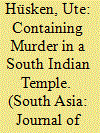

|
|
|
|
|
| Summary/Abstract |
On 3 September 2004, during the Pavitrotsava temple festival which serves to erase all ritual mistakes committed during the previous year, the manager of the Varadarāja Perumāl temple in Kanchipuram was brutally murdered. This murder constituted both a criminal act and a religious offence. In outlining its aftermath, this article analyses the highly dynamic responses to this multifaceted transgression, which depend on and signal the interaction between political power and religious authorities specific to time and place.
|
|
|
|
|
|
|
|
|
|
|
|
|
|
|
|
| 5 |
ID:
108891
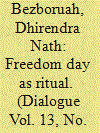

|
|
|
| 6 |
ID:
183699
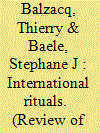

|
|
|
|
|
| Summary/Abstract |
The performance of ritual and the ritualisation of performance are the two main theoretical repertoires of ritual study in international politics and beyond. However, they also escalate tensions between those who insist on ritual's ability to operate by virtue of participants’ presence and those who believe that global networks of media call for a representational turn, which must tie participants and audiences across borders. Should we fail to understand how these distinct theoretical repertoires interact, it would be difficult to study international ritual, identify its functions, and trace its effects. Anchored in the sociology of ‘social occasions’, this article weaves ritual's patterns, properties, and resources into a coherent analytical framework. The framework enables us to better to grasp how actors move between/within different worlds (ritual and performance) and to what effects. The comparative study of two post-terrorism ritual occasions (the 2011 Rose March in Oslo and the 2015 Republican Marches in France) illustrates the usefulness of this theoretical proposition and its related framework.
|
|
|
|
|
|
|
|
|
|
|
|
|
|
|
|
| 7 |
ID:
188400
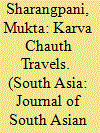

|
|
|
|
|
| Summary/Abstract |
This essay is a rumination on food, family and feminism. It investigates the enduring popularity of Karva Chauth among North Indian, dominant caste, married, working women in the San Francisco Bay Area. It highlights the significance of the fasting–feasting ritual in a range of self-shaping projects. By excavating the meanings embedded in food in women’s worlds, it privileges gendered experiential knowledge and forwards and repositions a nuanced understanding of agency, power and self-expression in the formation of diasporic identities.
|
|
|
|
|
|
|
|
|
|
|
|
|
|
|
|
| 8 |
ID:
188926
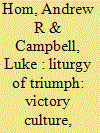

|
|
|
|
|
| Summary/Abstract |
Wartime is fundamentally important to the study of international politics but not especially well understood. In this paper, we use timing theory and the concept of liturgy to unpack the contemporary dynamics of US wartime. A theory of political timing posits that all temporalities derive from and symbolize underlying social processes, and that these timing efforts unfold according to a master organizing standard. Liturgy highlights the way that ritualized acts help participants commune with the sacred – whether this be God or the nation-state. Scrutinizing contemporary US culture practices, we combine these ideas to argue that the notion of victory, as enacted through a widespread set of performative routines, acts as an organizing standard that embeds and reifies wartime in US security policy and daily life. Prevalent ideals of winning wars gather together a stylized past, explicate present problems, and generate expectations about future problems and conflicts. We tabulate several highly influential examples of this liturgy of triumph from national calendars, commemorative sites and events, and cultural practices like spectator sports. In addition to normalizing a view of wartime as having clear beginnings and uniquely successful endings, the US liturgy of triumph highlights a growing gap in the country’s relationship to the use of force. Most of what performative war liturgies commemorate is ‘finished’; it has been seen, known, and ostensibly won. Yet, much of what defines 21st century conflict is anything but certain or victorious. Moreover, US victory culture has only grown more acute the longer the concrete victories fail to materialize, suggesting a tragic code at the heart of US security politics.
|
|
|
|
|
|
|
|
|
|
|
|
|
|
|
|
| 9 |
ID:
170002
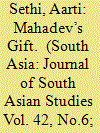

|
|
|
|
|
| Summary/Abstract |
In October 2016, protests erupted across southern India opposing a Supreme Court judgement banning an annual agricultural festival featuring jousts between men and bulls. The Court ruled the contests as infringing animal rights. Rural constituencies rallied behind the festival as a customary practice and symbol of agrarian culture. This essay suggests that the conflict between the two constituencies turns on whether animals are legal subjects or social persons. I analyse this festival-complex in Maharashtra to show that the ritual imagines animals not as rights-bearing species, but as members of the agricultural community. The rite does not disavow violence, rather it embeds its symbolisation within familial and productive relations between people and bullocks.
|
|
|
|
|
|
|
|
|
|
|
|
|
|
|
|
| 10 |
ID:
079929
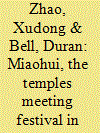

|
|
|
|
|
| Publication |
2007.
|
| Summary/Abstract |
We examine the multiple purposes and modalities that converge during a circuit of festivals, miaohui, which temples organize in recognition of local gods and which are attended reciprocally by temple representatives from the surrounding area in North China. The festivals involve intense expressions of devotion to one or more deities, while offering an opportunity for representatives of other villages to seek recognition through rather boisterous drumming and prolonged choreographed dancing. We note also the emergence of Mao as a great god whose legacy as Chairman of the CCP is projected in order to legitimate current Party leadership and their policy of reform while concurrently acting as a powerful denial of those same policies from the perspective of villagers.
|
|
|
|
|
|
|
|
|
|
|
|
|
|
|
|
| 11 |
ID:
152534
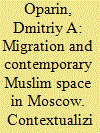

|
|
|
|
|
| Summary/Abstract |
Over the last fifteen years, the ethnic make-up of Moscow’s mosques has undergone significant change, while the number of practicing Muslims has grown manifold. These quantitative changes are connected with both the internal migration of people from the North Caucasian republics (a migration that had already begun in the early 1990s) and the external migration of natives of Central Asian states, primarily Uzbekistan, Tajikistan and Kirgizia (a mass migration dating from the 2000s). This paper is dedicated to two phenomena of contemporary Moscow Muslim life – the loud dhikr of the Kunta Hajji wird of the Qadiri tariqa, practiced by Chechens and Ingush; and the religious practices of the Central Asian “uninstitutionalized” mullas. Both spiritual practices are popular and have great significance for a considerable proportion of Moscow Muslims, including those who do not directly participate in them. What both practices have in common is also found in their marginal nature with regard both to institutionalized Moscow Islam and to the fundamentalist trend which is now gathering steam here. This is an attempt to identify some specific features of contemporary Moscow Islam through the analysis of certain practices.
|
|
|
|
|
|
|
|
|
|
|
|
|
|
|
|
| 12 |
ID:
089209
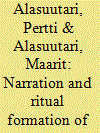

|
|
|
|
|
| Publication |
2009.
|
| Summary/Abstract |
The article is based on a case study of second generation Karelian migrants, whose parents had to move to other parts of Finland from the region of Karelia that was ceded to the Soviet Union at the end of World War II. The article poses the question, how long-lived diasporic identities are, and what are the conditions that affect assimilation or maintenance of a diasporic identity. In the Karelian migrants' case, already the first generation was quite successful in integrating with the rest of the Finnish society, and with the second generation, the integration has been practically complete, largely because of a short cultural distance between the evacuees and other Finns. A recent resurgence of interest in their roots by Karelian evacuees or their family members is primarily due to end of the Cold War and the possibility to freely and openly visit Karelia. Visiting Karelia has a ritual-like function for them. To that concrete, bodily experience of going there they can attach the abstract idea that in some ways they are Karelians and thus strengthen the emotional attachment to their roots. In that sense, visiting Karelia can also be described as a pilgrimage.
|
|
|
|
|
|
|
|
|
|
|
|
|
|
|
|
| 13 |
ID:
096517
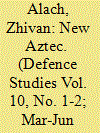

|
|
|
| 14 |
ID:
109000
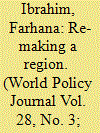

|
|
|
|
|
| Publication |
2011.
|
| Summary/Abstract |
Ethnographic research conducted among the semi-nomadic Muslim Jatts, who inhabit the interstices of the contemporary State both discursively as well as physically, helps us to critically interrogate the formulation of region as articulated both by the modern nation-state as well as contemporary religious ideology. In the official discourse of Gujarat State, the Jatts are represented as threats to the territorial integrity of the nation-state in general and to Gujarat in particular, their cross-border movements into Pakistan designed to destabilise the region. An ethnographic analysis of the state shows how state ideologies are produced discursively over time. This paper argues that travel and trade links in this region have produced historically-blurred boundaries between region, religion and now nation. These histories productively re-configure the current geopolitical iteration of space and belonging in contemporary Gujarat as enunciated by the state.
|
|
|
|
|
|
|
|
|
|
|
|
|
|
|
|
| 15 |
ID:
144164
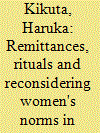

|
|
|
|
|
| Summary/Abstract |
This paper describes recent economic and social changes in Central Asian neighbourhood communities known as mahallas, using data from a town in Ferghana Valley. First, it examines how the increasing costs of life-cycle rituals are damaging the harmony of mahallas. Since 2007, more and more hosts have begun to outsource the provision of food and services for these rituals, using money acquired mostly through emigrant labour. This in turn lessens mahallas’ mutual aid practices, and reveals emerging economic disparities between neighbours. Secondly, the paper argues that emigration has had transformative effects on the lifestyles of Muslim women in mahallas. With the globalization of their economy, conventional local norms are becoming harder to obey, and some young and middle-aged women are choosing to live outside these norms. Dependence on emigrant labour and the associated remittances has significantly affected the lifestyles and morals of mahalla inhabitants.
|
|
|
|
|
|
|
|
|
|
|
|
|
|
|
|
| 16 |
ID:
132281
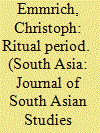

|
|
|
|
|
| Publication |
2014.
|
| Summary/Abstract |
Continuing further on the path laid out by Michael Allen's pioneering work on rituals that centre on Newar Buddhist girl children in Nepal, this study analyses liturgies pertaining to a religious practice called 'b?rh? pik?yagu' that ends a period of seclusion undergone by Newar girls before menarche. The article looks at three ritual manuals currently used by Buddhist priests in Lalitpur, Kathmandu and Bhaktapur, respectively. In its aim to supply a textual background to Allen's ethnography of this ritual, the study tries to place these manuals at the conjunction of other ritual textual genres, such as prescriptions for domestic rituals for women that include cosmological, demonological and pregnancy-related aspects, and attempts to explore their composition, their intention and their place within the larger ritual literature of Buddhism among the Newars.
|
|
|
|
|
|
|
|
|
|
|
|
|
|
|
|
| 17 |
ID:
110835


|
|
|
|
|
| Publication |
2012.
|
| Summary/Abstract |
Since the beginning of the 1990s, there has been growing academic interest in the speech act of apology. Both the nature of apologetic communicative processes and the potential of apologies to promote reconciliation remain, however, under debate. The aim of this article is to map common types of rituals found in what is termed 'the age of apology', to identify the processual and structural characteristics of these rituals, and to understand their contribution to restoring relations in the global arena. The analysis yields three types of rituals of apology: purification - that is, asymmetrical rituals in which the offender issues an apology in order to purify his or her dismal past but does not necessarily need the approval of an offended party; humiliation - that is, asymmetrical rituals in which the offended party forces the offender to participate in a degradation ritual as a condition for closure; and settlement - that is, symmetrical rituals in which both sides strive to restore relations. The theoretical and practical implications of these rituals are discussed.
|
|
|
|
|
|
|
|
|
|
|
|
|
|
|
|
| 18 |
ID:
114017
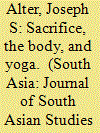

|
|
|
|
|
| Publication |
2012.
|
| Summary/Abstract |
In most general terms, hathayoga involves the internalisation and embodied literalisation of the Vedic fire sacrifice. Reflecting on the place of sacrifice in anthropological theory, and on the way in which sacrifice structures the relationship between humans and gods in terms of gift obligations, this paper explores the theoretical implications of hathayoga's embodied literalisation of a profoundly symbolic act. Although similar to various forms of ascetic renunciation, hathayoga is unique, it will be argued, in being structured as the physiological antithesis of religious ritual. Self-realisation based on the internalised yajna sacrifice undermines the binary structure of the sacred and the profane and makes god irrelevant. This raises theoretical questions concerning the social significance of a ritual that is anti-social on a number of different levels.
|
|
|
|
|
|
|
|
|
|
|
|
|
|
|
|
| 19 |
ID:
184154
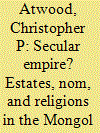

|
|
|
|
|
| Summary/Abstract |
Recent work in religious studies has emphasized how European colonial empires used the defining and constructing of religions and secularism as tools of rule. This article explores parallel processes in the Mongol empire (1206–1368) where ‘religion-making’ occurred in three areas: 1) a precise and legal definition of professional service estates among the conquered peoples that included the clergies of designated religions; 2) a broad and imprecise classification of nom or ‘way of life’ that partially overlapped with the clergies defined in the first category; and 3) a realm above all such sectarian distinctions destined for the Mongol ruling elite who alone were capable of living in free obedience to Heaven. The parallels and differences with classifications of the religious and the secular in European colonial empires shed light on how power interacts with cultural classification and practices.
|
|
|
|
|
|
|
|
|
|
|
|
|
|
|
|
| 20 |
ID:
104064
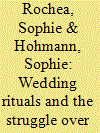

|
|
|
|
|
| Publication |
2011.
|
| Summary/Abstract |
This article argues that rituals are the creative link between state hegemony and the everyday practices of ordinary people. Based on the idea of ritual as experimental technology developed by the Comaroffs (1993), we analyse the Tajik wedding as a means to deal creatively with the tension between the nation-state's claims to exert control over its citizens, on the one hand, and the use of traditions as historical continuity to create a common identity, on the other. Whereas weddings conform to state law and have thus adapted to the changing legal frames during the Soviet period and continue to do so in independent Tajikistan, they have also been used as rituals of cultural resistance in which ethnic, local and national identities are asserted against homogenizing efforts. Taking an historical perspective on weddings, this article contributes to the debate on the role of rituals in the creation and contestation of national identity and state ideologies.
|
|
|
|
|
|
|
|
|
|
|
|
|
|
|
|
|
|
|
|
|